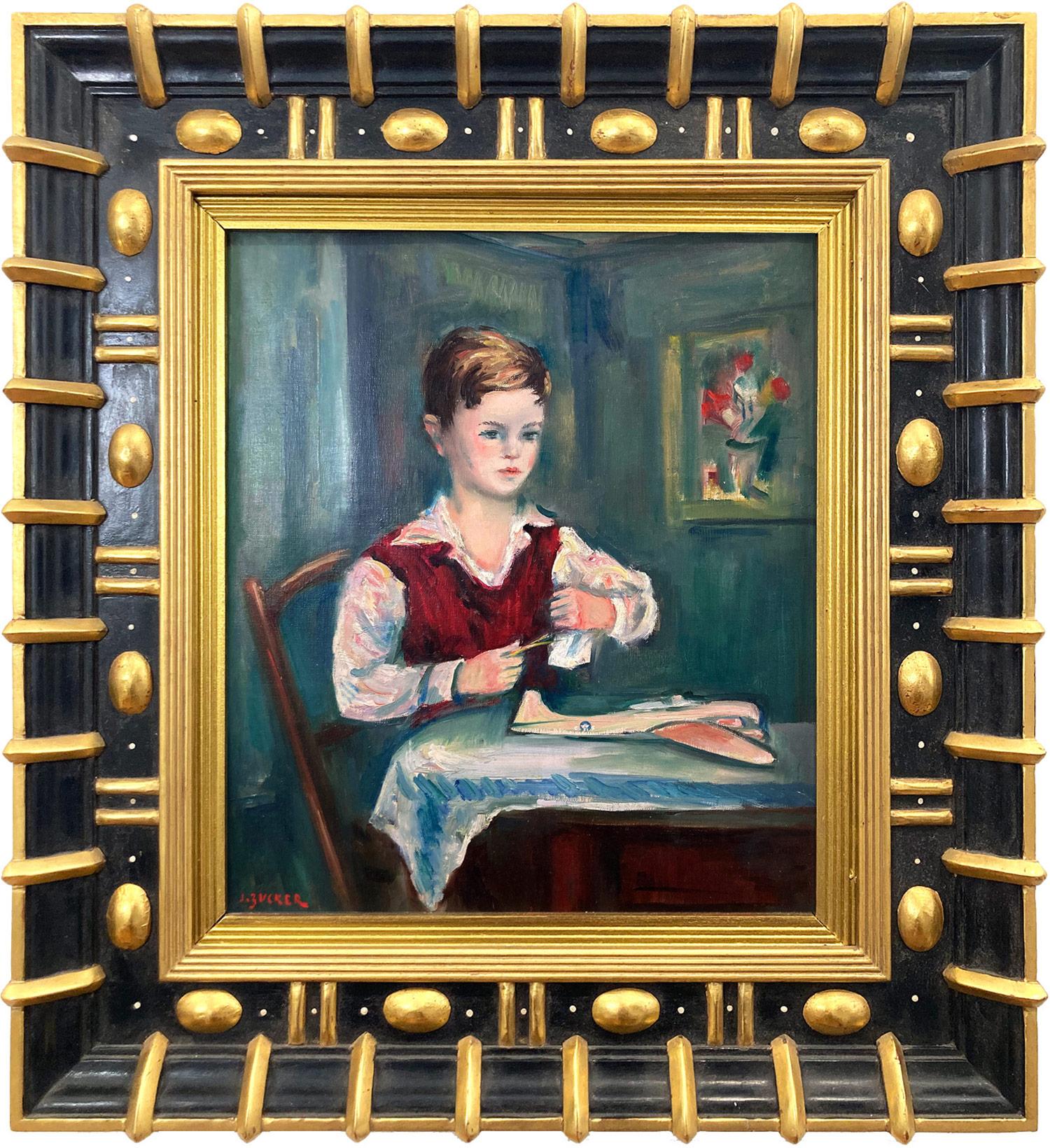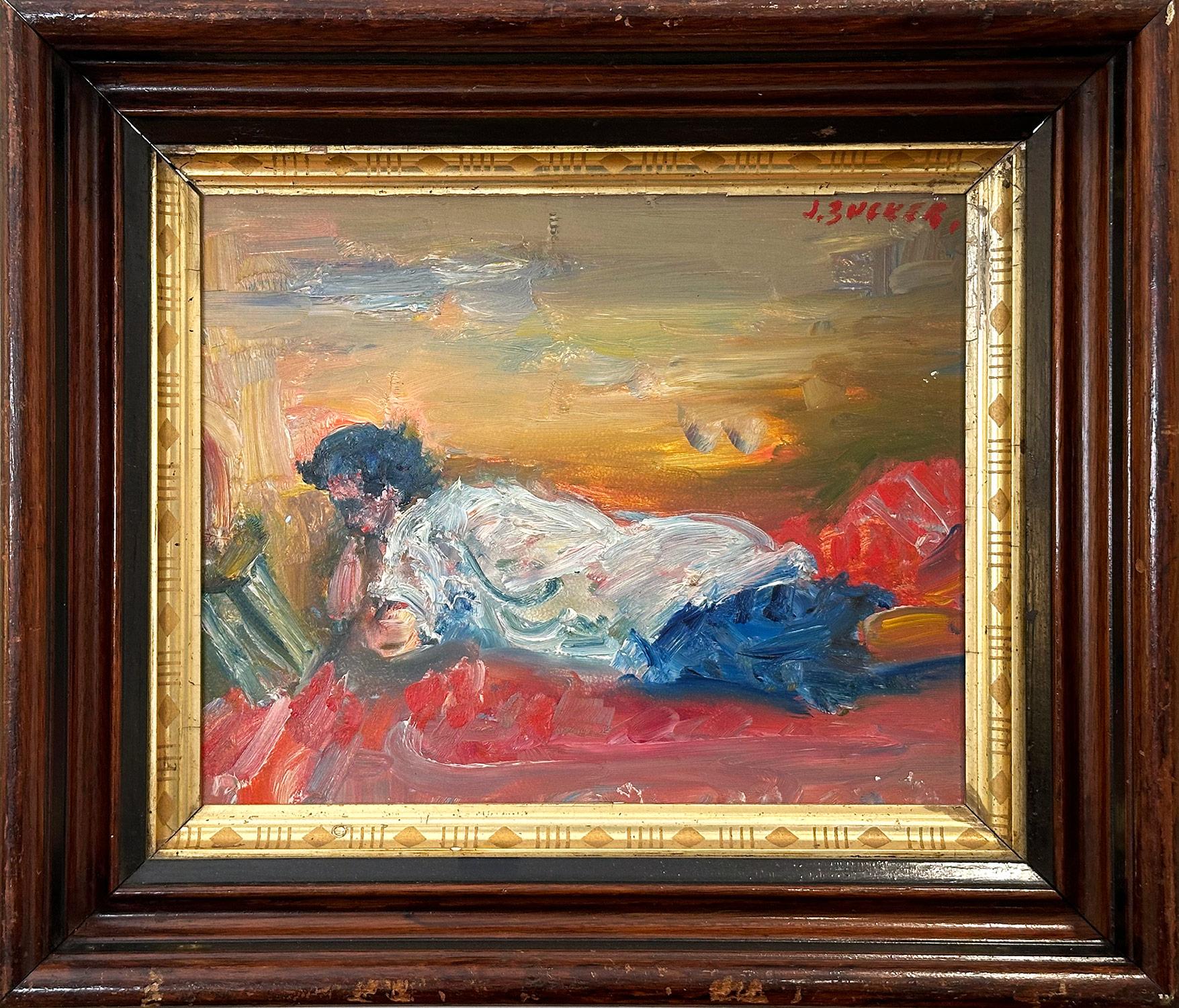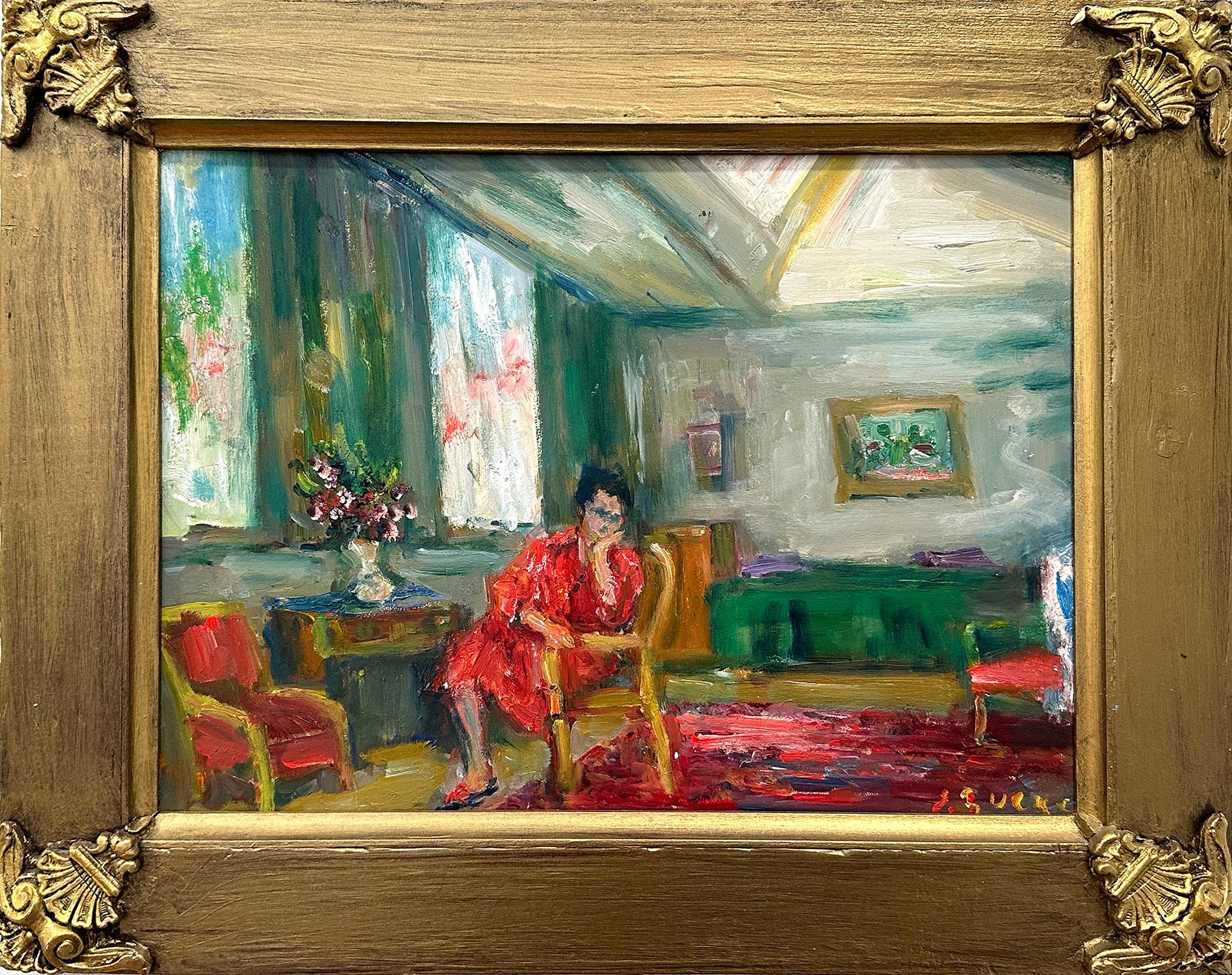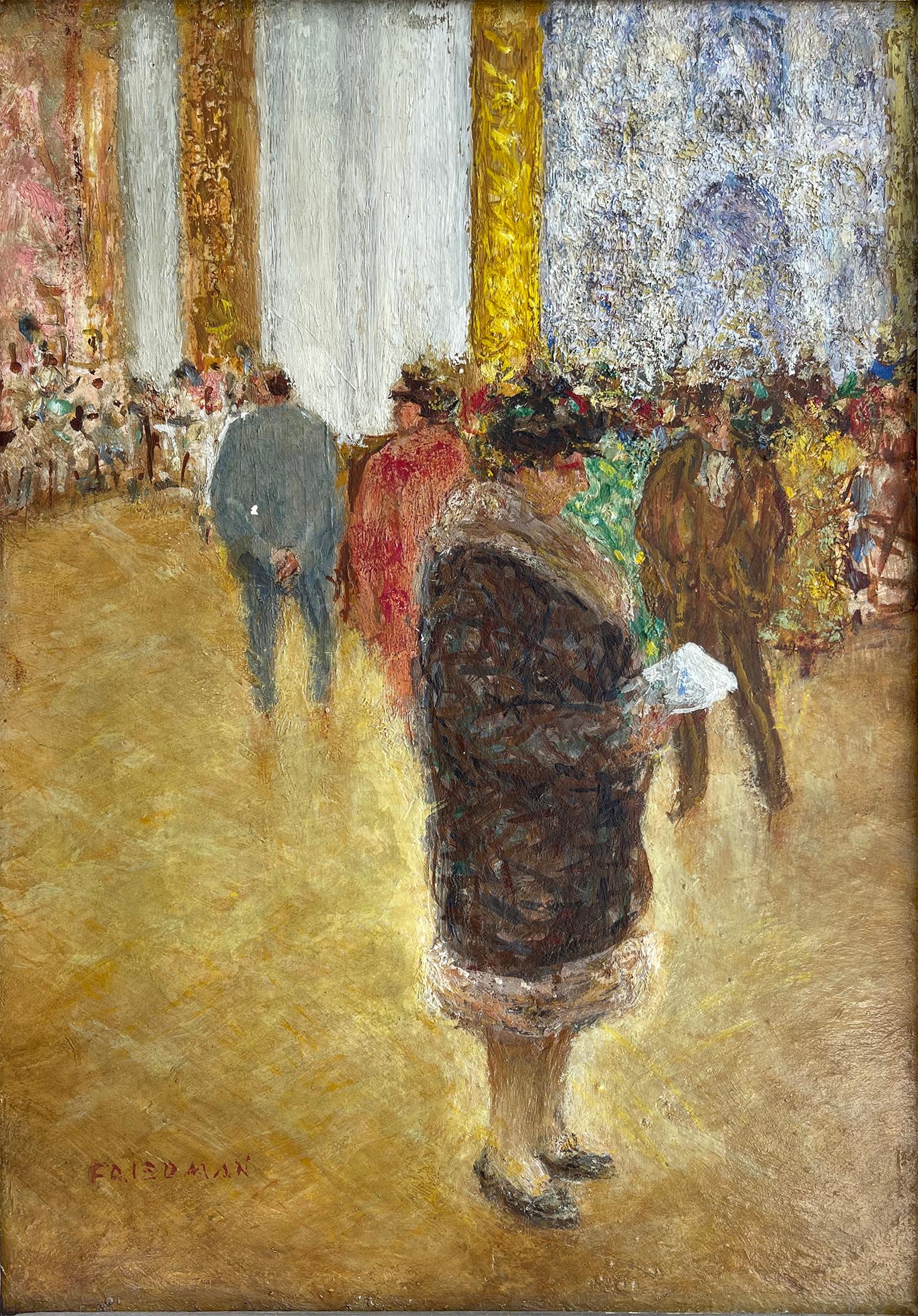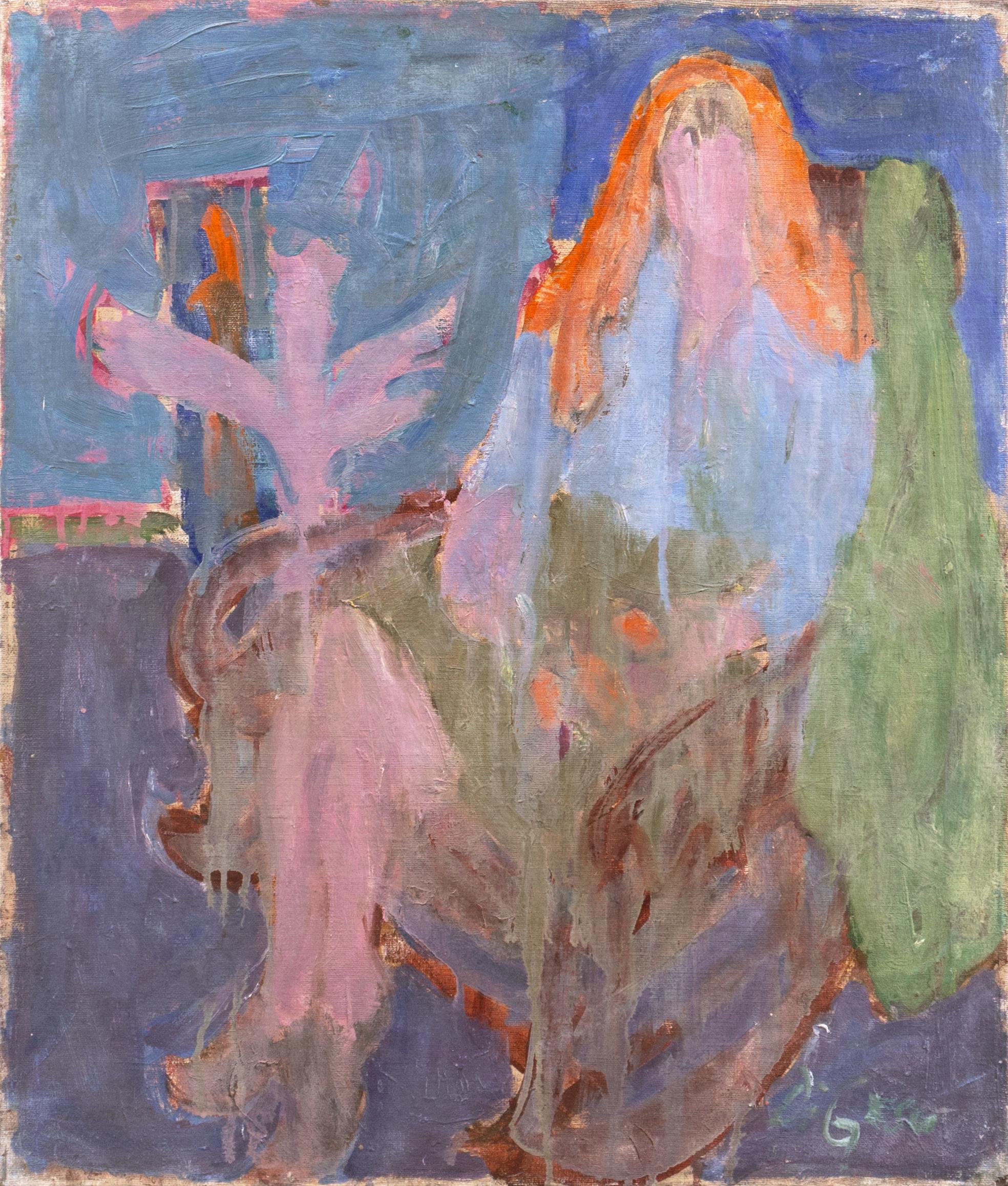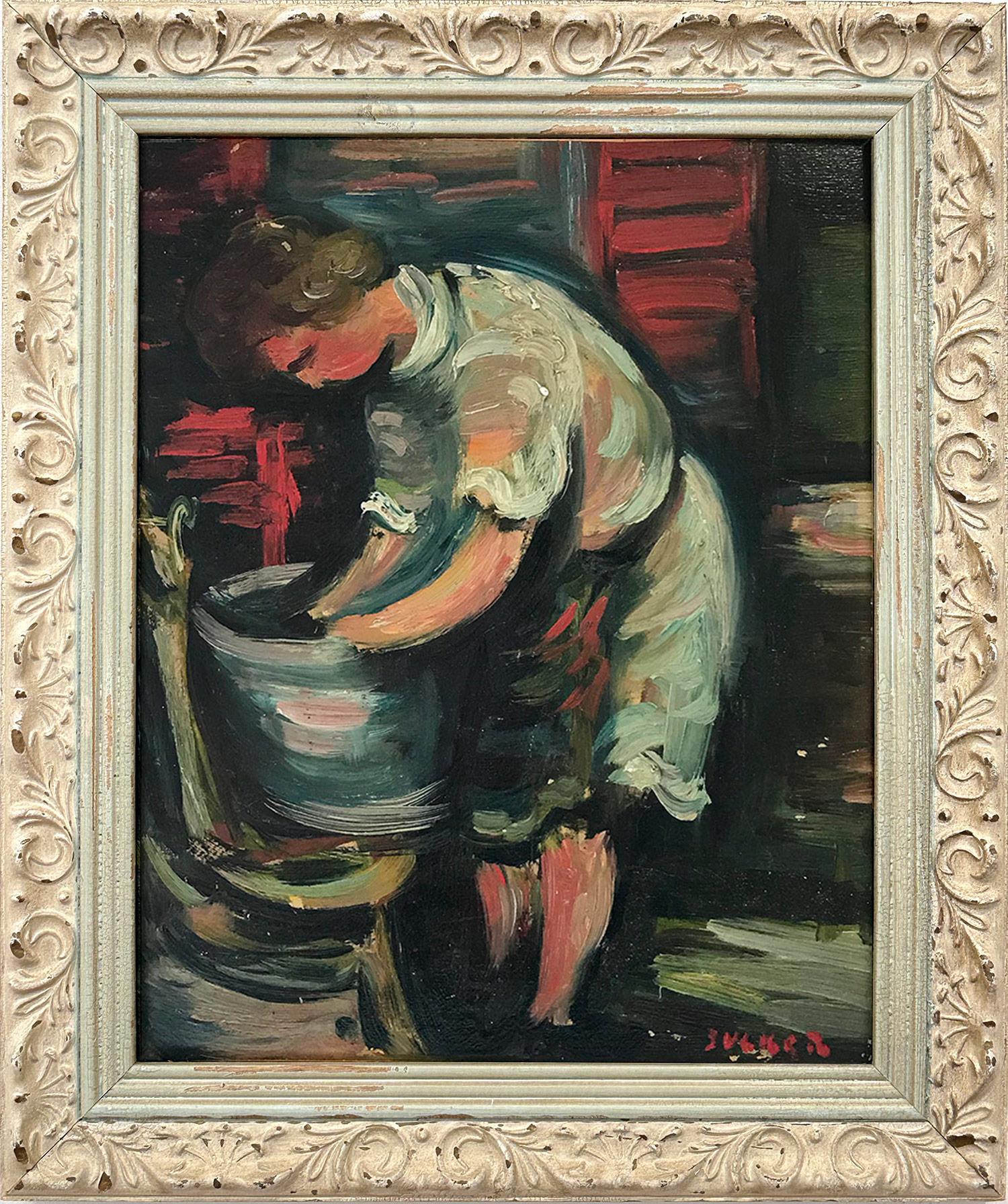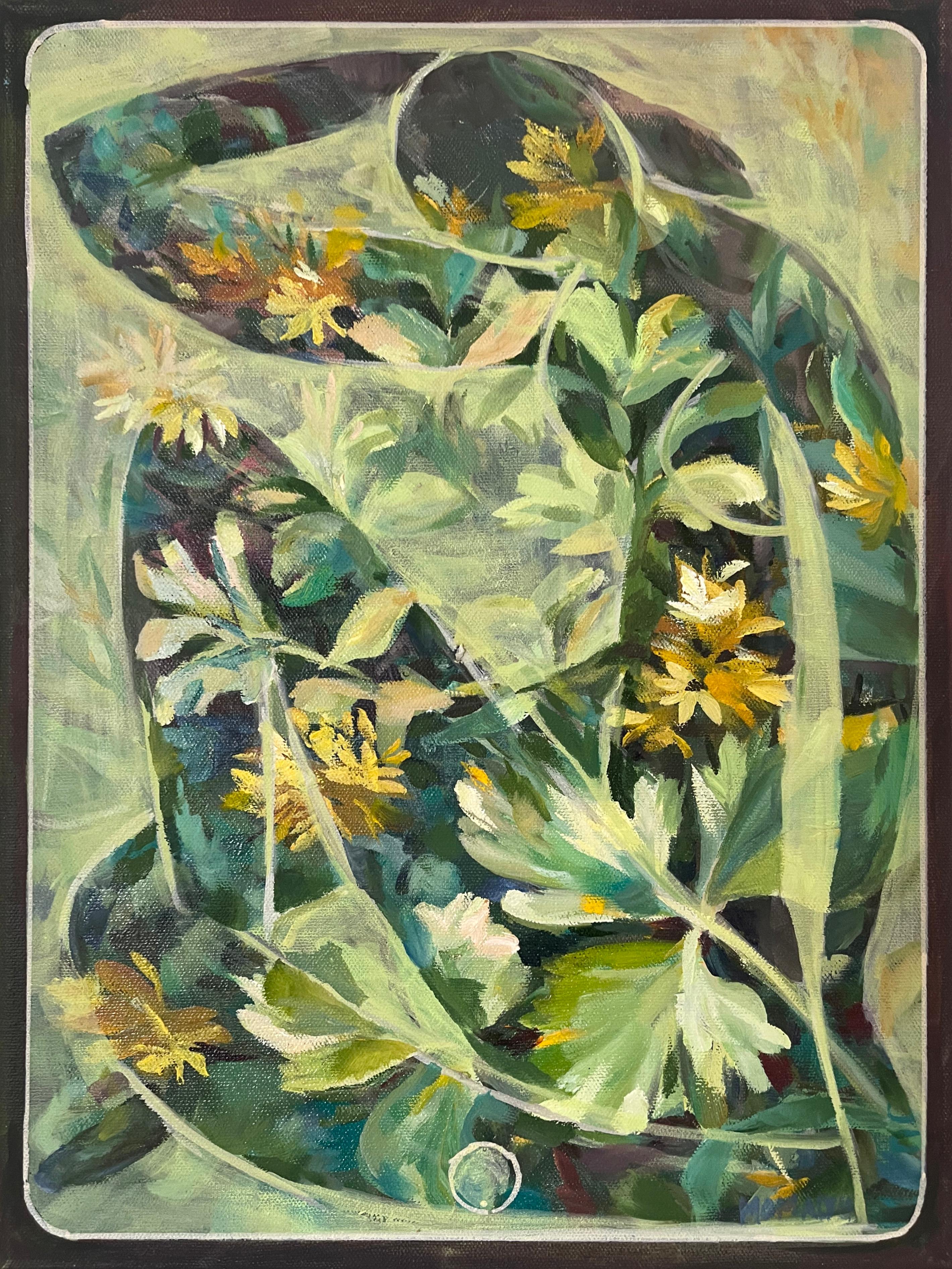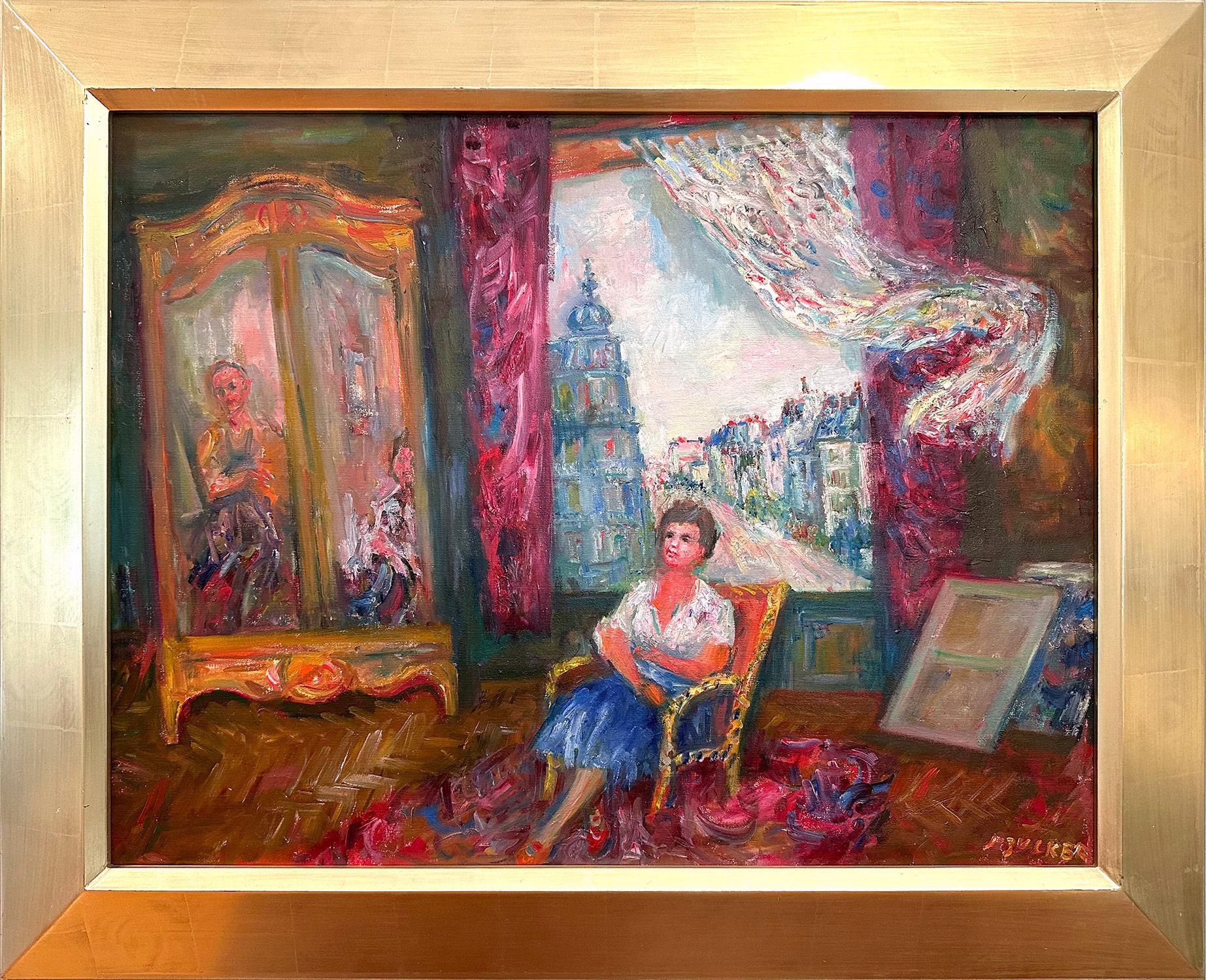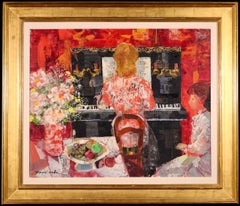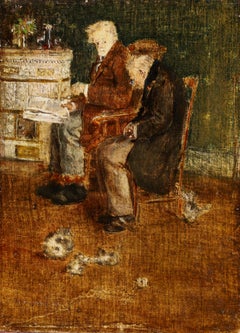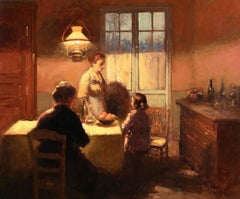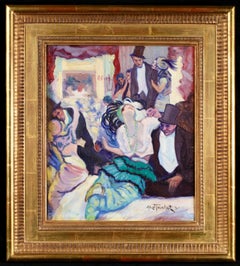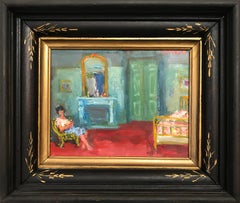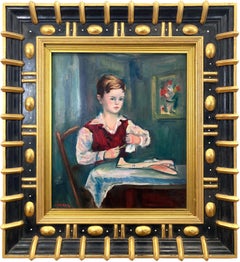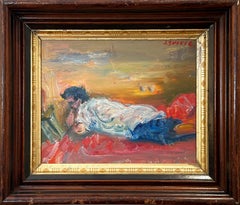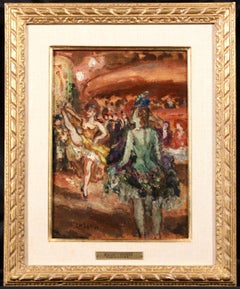
Le Can-Can – Bal Tabarin - Post Impressionist Figurative Oil by Marcel Cosson
View Similar Items
Want more images or videos?
Request additional images or videos from the seller
1 of 15
Jean-Louis-Marcel CossonLe Can-Can – Bal Tabarin - Post Impressionist Figurative Oil by Marcel Cossonc. 1930
c. 1930
About the Item
- Creator:Jean-Louis-Marcel Cosson (1878 - 1956, French)
- Creation Year:c. 1930
- Dimensions:Height: 18 in (45.72 cm)Width: 13 in (33.02 cm)
- Medium:
- Movement & Style:
- Period:
- Condition:Very good original condition.
- Gallery Location:Marlow, GB
- Reference Number:Seller: LFA05131stDibs: LU415311791142
About the Seller
5.0
Platinum Seller
Premium sellers with a 4.7+ rating and 24-hour response times
Established in 2001
1stDibs seller since 2016
703 sales on 1stDibs
Typical response time: 1 hour
Authenticity Guarantee
In the unlikely event there’s an issue with an item’s authenticity, contact us within 1 year for a full refund. DetailsMoney-Back Guarantee
If your item is not as described, is damaged in transit, or does not arrive, contact us within 7 days for a full refund. Details24-Hour Cancellation
You have a 24-hour grace period in which to reconsider your purchase, with no questions asked.Vetted Professional Sellers
Our world-class sellers must adhere to strict standards for service and quality, maintaining the integrity of our listings.Price-Match Guarantee
If you find that a seller listed the same item for a lower price elsewhere, we’ll match it.Trusted Global Delivery
Our best-in-class carrier network provides specialized shipping options worldwide, including custom delivery.More From This Seller
View AllLe Piano - Post Impressionist Figurative Interior Painting by Emilio Grau Sala
By Emilio Grau Sala
Located in Marlow, Buckinghamshire
Signed and titled oil on canvas figure in interior circa 1950 by Spanish post impressionist Emilio Grau Sala. The work depicts a red-haired lady in a red dress seated at a piano. A y...
Category
1950s Post-Impressionist Figurative Paintings
Materials
Oil, Canvas
Deux vieillards aux chatons - Impressionist Figurative Oil by J F Raffaelli
By Jean-Francois Raffaelli
Located in Marlow, Buckinghamshire
Signed figures in interior oil on panel by French impressionist painter Jean-Francois Raffaelli. The piece depicts two old men seated in an interior. One is reading his paper as the other naps and there are several kittens on the floor. Painted in the artist's distinctive style.
Signature:
Signed lower left
Dimensions:
Framed: 9.5"x8"
Unframed: 5.5"x4"
Provenance:
Brame & Lorenceau have confirmed the authenticity of this work and it will be included in the digital catalogue raisonne of the painter which is under preparation
A certificate of authenticity fromBrame & Lorenceau accompanies this painting
Private collection - United States
Original artists label verso
Jean-François Raffaëlli's father was a failed Italian businessman and Raffaëlli himself was, among other things, a church chorister, actor and theatre singer. He then studied under Gérôme at the École des Beaux-Arts in Paris. He travelled to Italy, Spain and Algeria and on his return to France settled in Asnières.
In 1876, on a trip to Brittany, he first saw the potential of realist subject matter, if treated seriously. He became involved in meetings of artists at the Café Guerbois, where the Impressionist painters used to gather. As a result, Degas, contrary to the advice of the group, introduced Raffaëlli to the Impressionist exhibitions - according to one uncertain source as early as the very first exhibition, at the home of Nadar, and certainly to those of 1880 and 1881.
In 1904, Raffaëlli founded the Society for Original Colour Engraving. He first exhibited at the Salon de Paris in 1870 and continued to exhibit there until he joined the Salon des Artistes Français in 1881, where he earned a commendation in 1885, was made Chevalier of the Légion d'Honneur in 1889 and in the same year was awarded a gold medal at the Exposition Universelle. In 1906 he was made Officier of the Légion d'Honneur. He was also a member of the Société Nationale des Beaux-Arts. In 1884, a private exhibition of his work cemented his reputation.
He contributed to several newspapers such as The Black Cat (Le Chat Noir) in 1885 and The French Mail (Le Courrier Français) in 1886 and 1887. He published a collection entitled Parisian Characters, which captured his favourite themes of the street, the neighbourhood and local people going about their lives. In 1880 he participated, with Forain, on the illustration of Joris Karl Huysmans' Parisian Sketches (Croquis Parisiens). He also illustrated Huysman's Works. As well as working as an illustrator, he also made etchings and coloured dry-points.
His early attempts at painting were genre scenes, but once he was settled in Asnières he started to paint picturesque views of Parisian suburbs. From 1879 onwards, his subject matter drew on the lives of local people. These popular themes, which he treated with humanity and a social conscience, brought him to the attention of the social realist writers of the time such as Émile Zola. In addition to his realist style, Raffaëlli's dark palette, which ran contrary to the Impressionist aesthethic, helped to explain the opposition of those painters to his participation in their exhibitions. More concerned with drawing than colour, he used black and white for most of his paintings. Towards the end of his life, he lightened his palette, but without adopting any other principles of the Impressionist technique.
After painting several portraits, including Edmond de Goncourt and Georges Clémenceau, he returned to genre painting, particularly scenes of bourgeois life. Later in his career, he painted mainly Breton-inspired sailors and views of Venice. His views of the Paris slums and the fortifications, sites which have almost completely disappeared, went some way towards establishing a genre in themselves and perpetuated the memory of the area: The Slums, Rag-and-Bone Man, Vagabond, Sandpit, In St-Denis, Area of Fortifications. His realistic and witty portrayal of typical Parisian townscapes accounts for his enduring appeal.
Born in Paris, he was of Tuscan descent through his paternal grandparents. He showed an interest in music and theatre before becoming a painter in 1870. One of his landscape paintings was accepted for exhibition at the Salon in that same year. In October 1871 he began three months of study under Jean-Léon Gérôme at the École des Beaux-Arts in Paris; he had no other formal training.
Raffaëlli produced primarily costume pictures until 1876, when he began to depict the people of his time—particularly peasants, workers, and ragpickers seen in the suburbs of Paris—in a realistic style. His new work was championed by influential critics such as J.-K. Huysmans, as well as by Edgar Degas.
The ragpicker became for Raffaëlli a symbol of the alienation of the individual in modern society. Art historian Barbara S. Fields has written of Raffaëlli's interest in the positivist philosophy of Hippolyte-Adolphe Taine, which led him to articulate a theory of realism that he christened caractérisme. He hoped to set himself apart from those unthinking, so-called realist artists whose art provided the viewer with only a literal depiction of nature. His careful observation of man in his milieu paralleled the anti-aesthetic, anti-romantic approach of the literary Naturalists, such as Zola and Huysmans.
Degas invited Raffaëlli to participate in the Impressionist exhibitions of 1880 and 1881, an action that bitterly divided the group; not only was Raffaëlli not an Impressionist, but he threatened to dominate the 1880 exhibition with his outsized display of 37 works. Monet, resentful of Degas's insistence on expanding the Impressionist exhibitions by including several realists, chose not to exhibit, complaining, "The little chapel has become a commonplace school which opens its doors to the first dauber to come along."An example of Raffaëlli's work from this period is Les buveurs d'absinthe (1881, in the California Palace of Legion of Honor Art Museum in San Francisco). Originally titled Les déclassés, the painting was widely praised at the 1881 exhibit.
After winning the Légion d'honneur in 1889, Raffaëlli shifted his attention from the suburbs of Paris to city itself, and the street scenes that resulted were well received by the public and the critics. He made a number of sculptures, but these are known today only through photographs.[2] His work was also part of the painting event in the art competition at the 1912 Summer Olympics. In the later years of his life, he concentrated on color printmaking. Raffaëlli died in Paris on February 11, 1924
Museum and Gallery Holdings:
Béziers: Peasants Going to Town
Bordeaux: Bohemians at a Café
Boston: Notre-Dame; Return from the Market
Brussels: Chevet of Notre-Dame; pastel
Bucharest (Muz. National de Arta al României): Market at Antibes; Pied-à-terre
Copenhagen: Fishermen on the Beach
Douai: Return from the Market; Blacksmiths
Liège: Absinthe Drinker...
Category
1890s Impressionist Figurative Paintings
Materials
Oil, Panel
Interieur - Effet de Lampe - Impressionist Interior Oil by Edouard Cortes
By Édouard Leon Cortès
Located in Marlow, Buckinghamshire
Signed figures in interior oil on canvas circa 1920 by sought after French impressionist painter Edouard Leon Cortes. This charming and nostalgic work depicts a family in a typical Breton kitchen scene. An elderly lady is seated at the table with her back to the artist and a young girl also sits at the table beside a bowl of oranges and a carafe of red wine. Another lady stands at the table under the light of the lamp.
Signature:
Signed lower right
Dimensions:
Framed: 29.5"x34"
Unframed: 21.5"x26"
Provenance:
Salon des Independants - 1922 exhibition
Galleries Maurice Sternberg - Chicago
Original artists label with title and number "9" on the reverse.
Edouard Leon Cortes, the son of the painter Antonio Cortès, was sent to the front during World War I to sketch enemy positions. In civilian life, his base was in Lagny in the former studio of Cavallo-Peduzzi. Although he travelled extensively in France. Notably in Normandy, Brittany, the Champagne region and Savoy painting...
Category
1920s Impressionist Figurative Paintings
Materials
Canvas, Oil
Le Cabaret - Montmartre 1897- Impressionist Figurative Oil by Louis Abel Truchet
By Louis Abel-Truchet
Located in Marlow, Buckinghamshire
Signed and dated oil on canvas figures in interior by French impressionist painter Louis Abel Truchet. The piece depicts revellers at a French cabaret Montmartre.
Signature:
Signed ...
Category
1890s Impressionist Figurative Paintings
Materials
Canvas, Oil
Early Evening - Brittany - Impressionist Interior Oil Painting by Edouard Cortes
By Édouard Leon Cortès
Located in Marlow, Buckinghamshire
Signed figures in interior oil on canvas circa 1925 by sought after French impressionist painter Edouard Leon Cortes. This charming and nostalgic work depicts a family in a typical Breton kitchen scene. A lady is seated at the table while another slices a loaf of bread for a young girl. The view from the large window shows cottages in the distance and the last light of the day on the horizon as night falls. The light of an overhead oil burner illuminates the room.
Signature:
Signed lower left
Dimensions:
Framed: 30"x25"
Unframed: 26"x21"
Provenance:
This work has been examined and authenticated by Mme. Nicole Verdier and will appear in Tome IV of the catalogue raisonne. An accompanying certificate from Mme. Verdier is available upon request at a charge of 960 EUR.
Private French collection
Edouard Leon Cortes, the son of the painter Antonio Cortès, was sent to the front during World War I to sketch enemy positions. In civilian life, his base was in Lagny in the former studio of Cavallo-Peduzzi. Although he travelled extensively in France. Notably in Normandy, Brittany, the Champagne region and Savoy...
Category
Early 20th Century Impressionist Figurative Paintings
Materials
Canvas, Oil
The Piano Recital - Impressionist Figurative Interior Oil by Frederick Frieseke
By Frederick Carl Frieseke
Located in Marlow, Buckinghamshire
Signed and dated oil on canvas figure in interior painting by American impressionist painter Frederick Carl Frieseke. The piece depicts a young girl in a pink dress seated at a piano...
Category
1920s American Impressionist Figurative Paintings
Materials
Oil, Canvas
You May Also Like
Francisco Bores, Sans titre
By Francisco Bores
Located in Madrid, ES
FRANCISCO BORES
Spanish, 1898 - 1972
SANS TITRE
signed and dated "Borès 42" (lower left)
oil on panel
13-3/4 x 10-5/8 inches (35 x 27 cm.)
framed: 19 x 15-3/4 inches (48 x 40 cm.)
BIBLIOGRAPHY:
Francisco Bores, Reasoned Catalogue, Volume I - Painting 1917-1944, Museo Nacional Centro de Arte Reina Sofía, Madrid, 2003, nº 1942 / 63, reproduced in p. 494
PROVENANCE
Carmen Bores Collection, Francisco Bores daughter
Private Collection, Madrid
Francisco Bores López (Madrid, May 5, 1898 - Paris, May 10, 1972) was a Spanish painter of the so-called New School of Paris.
His artistic training originated both in the Cecilio Pla painting academy, where he met Pancho Cossío, Manuel Ángeles Ortiz or Joaquín Peinado, and in the literary gatherings in Madrid related to ultraism.
At this time he made engravings and woodcuts for a large number of magazines such as Horizonte, Cruz y Raya, Index, Revista de Occidente. In 1922 he participated in the National Exhibition of Fine Arts.
In 1925 he participated in the first exhibition of the Iberian Artists Society. The limited success of this exhibition pushes him to go to Paris. In this city he shared a studio with the Spanish painter Pancho Cossío and also met Picasso and Juan Gris.
In 1927 he held his first solo exhibition in Paris. From this moment on, Bores integrates himself into the Parisian artistic environment where he will live practically his entire life. In 1928, his first exhibition in a gallery in the United States, in 1930 he exhibited again, within a group exhibition at the Museum of Modern Art in New York.
In the following years, he continued exhibiting in different galleries in Paris, such as the Georges Petit Gallery, the Bernheim Gallery and the Vavin Raspail Gallery. He also participates in several group exhibitions, highlighting the Exhibition of Contemporary Spanish Art...
Category
1940s Fauvist Interior Paintings
Materials
Oil, Panel
"Interior Scene with Figure and Mantel" Post-Impressionism Oil Painting on Panel
By Jacques Zucker
Located in New York, NY
A cozy little jewel, we are charmed by the rich choice of color and intimate details throughout this miniature work. This painting depicts a woman in her bedroom near the Mantel with...
Category
20th Century Post-Impressionist Interior Paintings
Materials
Oil, Panel
"Young Boy with Toy Airplane" Post-Impressionist French Oil Painting on Canvas
By Jacques Zucker
Located in New York, NY
This painting depicts a whimsical portrait of a young boy with light brown hair against a viridian green background. The piece is done in a highly impressionistic manner and is a won...
Category
20th Century Post-Impressionist Figurative Paintings
Materials
Canvas, Oil, Wood Panel
"Laying Figure Reading" Post-Impressionist Colorful Oil Painting on Panel Framed
By Jacques Zucker
Located in New York, NY
This painting depicts a whimsical scene of a figure reclining and reading. The figure is done in a quick way, where the scene almost is abstracted. The bright colors and quick brush ...
Category
20th Century Post-Impressionist Figurative Paintings
Materials
Oil, Panel
"Interior Scene with Figure and Flowers" Post-Impressionist Oil Painting Framed
By Jacques Zucker
Located in New York, NY
An intimate interior scene of a woman reclining in her living room with a bouquet of flowers on a sunny afternoon. We are charmed by the rich choice of color and intimate details thr...
Category
20th Century Post-Impressionist Interior Paintings
Materials
Oil, Panel
Museum Piece #2 Art Lover in Museum Exhibition
By Arnold Friedman
Located in Miami, FL
Arnold Friedman studied with Robert Henri and Kenneth Hayes Miller at the Art Students League in 1905 .
Yet as he developed his style he abandoned the academic influence of his teacher.
He started experimenting with materials and techniques.
Friedmans intimate style recalls a variety of post-impressionist artists such as Pointillism of Pisarro, Vuillard and Nabis, and perhaps even Seurat.
His thick application of paint has definitive textual impasto that was influenced by his trip to Paris in 1909.
In "Museum Piece...
Category
1920s Post-Impressionist Figurative Paintings
Materials
Oil, Wood Panel

